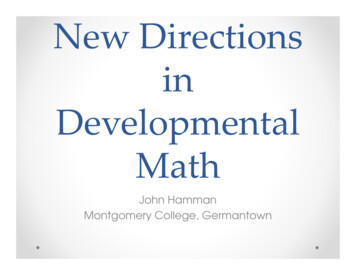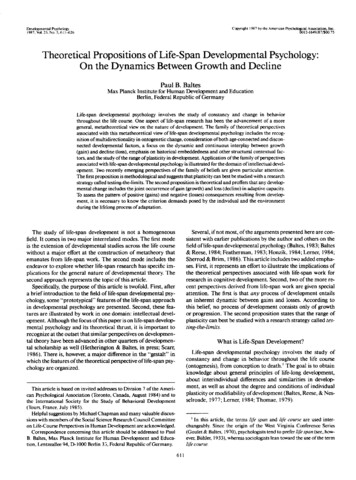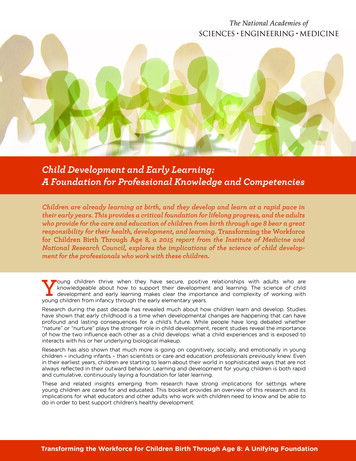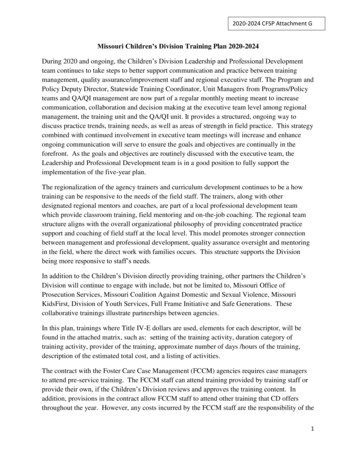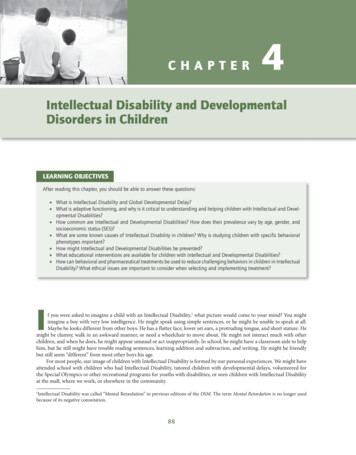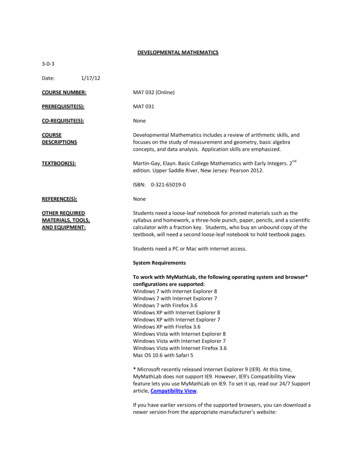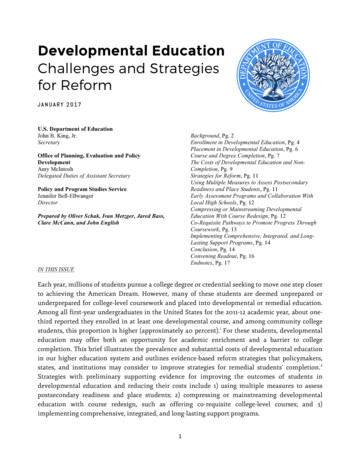
Transcription
Developmental EducationChallenges and Strategiesfor ReformJANUARY 2017U.S. Department of EducationJohn B. King, Jr.SecretaryBackground, Pg. 2Enrollment in Developmental Education, Pg. 4Placement in Developmental Education, Pg. 6Course and Degree Completion, Pg. 7The Costs of Developmental Education and NonCompletion, Pg. 9Strategies for Reform, Pg. 11Using Multiple Measures to Assess PostsecondaryReadiness and Place Students, Pg. 11Early Assessment Programs and Collaboration WithLocal High Schools, Pg. 12Compressing or Mainstreaming DevelopmentalEducation With Course Redesign, Pg. 12Co-Requisite Pathways to Promote Progress ThroughCoursework, Pg. 13Implementing Comprehensive, Integrated, and LongLasting Support Programs, Pg. 14Conclusion, Pg. 14Convening Readout, Pg. 16Endnotes, Pg. 17Office of Planning, Evaluation and PolicyDevelopmentAmy McIntoshDelegated Duties of Assistant SecretaryPolicy and Program Studies ServiceJennifer Bell-EllwangerDirectorPrepared by Oliver Schak, Ivan Metzger, Jared Bass,Clare McCann, and John EnglishIN THIS ISSUEEach year, millions of students pursue a college degree or credential seeking to move one step closerto achieving the American Dream. However, many of these students are deemed unprepared orunderprepared for college-level coursework and placed into developmental or remedial education.Among all first-year undergraduates in the United States for the 2011-12 academic year, about onethird reported they enrolled in at least one developmental course, and among community collegestudents, this proportion is higher (approximately 40 percent).1 For these students, developmentaleducation may offer both an opportunity for academic enrichment and a barrier to collegecompletion. This brief illustrates the prevalence and substantial costs of developmental educationin our higher education system and outlines evidence-based reform strategies that policymakers,states, and institutions may consider to improve strategies for remedial students’ completion. 2Strategies with preliminary supporting evidence for improving the outcomes of students indevelopmental education and reducing their costs include 1) using multiple measures to assesspostsecondary readiness and place students; 2) compressing or mainstreaming developmentaleducation with course redesign, such as offering co-requisite college-level courses; and 3)implementing comprehensive, integrated, and long-lasting support programs.1
BackgroundIn the past 50 years, the U.S. has made dramatic strides in opening up college opportunitiesto students from all backgrounds, particularly with the growth in enrollment at community collegesand other open-access institutions. With this growth in educational opportunity came an influx ofstudents, not all of whom were able to meet the academic rigor of a college level education.Developmental education emerged as an educational strategy for assisting students who wereperceived as underprepared for the academic rigor of college-level coursework (see infographic onthe next page). Institutions created sub-baccalaureate reading, writing, and math course sequences,often with multiple levels of instruction in each subject area. Some students were left to take one ortwo developmental courses, while others had to take a larger number of courses to pass multiplelevels of coursework in order to progress to college-level classes.3 In many cases, students wereplaced into these courses based on a single assessment. Although these policies and practices werereferred to by terms as varied as “developmental education,” “remedial education,” and “collegereadiness courses,” they all consisted of strategies to help underprepared students acquire the skillsand knowledge needed to move into college-level courses.4 (In this brief, the terms “developmentaleducation” or “developmental courses” and “remediation” are used interchangeably.)While some would argue that developmental education still serves its original purpose, a recentcall among policymakers and educators for higher college completion rates and improved curriculahas led to a reexamination of developmental education by states, institutions, and policymakers.5,6Longitudinal tracking of student progression through developmental courses has drawn attentionto low course and degree completion rates, particularly in math courses.7,8 In addition, institutions’use of a single, high-stakes test to assess readiness has come under criticism. Many stakeholdershave pushed for changes in colleges’ practices with respect to placement in developmental courses,including using multiple measures for assessment and placement.9 Other reforms to developmentaleducation have included (but are not limited to) comprehensive and integrated support programs; contextualized instruction (e.g., aligning content with the student’s major or program ofstudy); early assessment programs for at-risk high school students and accelerated academicprograms to help prepare high school students for the rigors of college-level course work; enhanced and early-alert advising; performance-based monetary incentives for students; practices to accelerate, compress, or mainstream developmental education; practices to modify information used to make placement decisions; and practices to teach metacognition, productive persistence, and college success skills.102
3
Enrollment in Developmental CourseworkEstimates of the prevalence of college remediation vary due to incomplete data andinconsistent definitions of what constitutes developmental coursework across states, collegesystems, and institutions. Among students who entered their first institution in 2010–11, about 35percent of beginning postsecondary students took at least one developmental course during thefollowing four years. Moreover, while remedial education is often perceived as predominantly anissue in two-year institutions, remediation was common across all sectors and levels of highereducation (see Exhibit 1). Note that for-profit institutions that predominantly award subbaccalaureate degrees tend to place fewer students in developmental education in part becausethese institutions focus more on career and vocational programs that may not require as muchpreparation in foundational topics.Exhibit 1: Developmental Course-Taking Among 2010-11 Beginning Postsecondary Students, by Sector of Institutionfrom 2010 through 2014EverTakenAnyDevelopmentalCourseThrough2013- ‐1460%51%35%30%29%30%20%19%14%0%TotalPublicfour- ‐yearPrivate,nonprofitfour- ‐yearPrivate,for- ‐profit4- ‐yearPublictwo- ‐yearPrivate,for- ‐profittwo- ‐yearPrivate,for- ‐profit two- ‐yearNOTE: Figures reflect percentage students who took developmental courses within three years of enrolling at their first institution.Students attending less than four-year private, nonprofit institutions included in total estimate but not disaggregated by sector due to small n-size.Sector defined as the student’s first institution.SOURCE: U.S. Department of Education, National Center for Education Statistics, 2010-11 Beginning Postsecondary Students Longitudinal Study,Second Follow-up (BPS:10/14).To recreate the estimates above in PowerStats (https://nces.ed.gov/datalab), use the QuickRetrieve code: cnbgb6a.4
Remediation is also highly concentrated among students with limited academicpreparation. Among those beginning school at public two-year institutions in academic year 2003–04, 75 percent of students who were less prepared (i.e., with lower GPAs, lower level and fewer yearsof math coursework, and/or low ACT/SAT scores) took developmental courses during their collegeyears, compared with 48 percent of strongly prepared students.11 Among those beginning at publicfour-year institutions, the remediation rate for less prepared students was more than four timesthat of strongly prepared students (77 percent, compared with 18 percent).12Participation in developmental education is also more common among several demographicgroups, including black and Hispanic students and students from low-income backgrounds. 13,14 Atpublic four-year institutions, first-generation students are particularly likely to enroll indevelopmental education courses.15,16 Among all beginning postsecondary students, an estimated 58percent of Hispanic students, 57 percent of black students, 39 percent of Pell grant recipients, and40 percent of first-generation college students enrolled in a developmental course between 2010and 2014. 17 Still, despite differences between particular groups of students, developmentaleducation overall is widespread, affecting both disadvantaged and advantaged populations. 18 ,19Thirty percent of white students, over 34 percent of Asian students, 31 percent of non-Pell students,and 27 percent of students who have at least one parent who attained a bachelor’s degree took adevelopmental course among students who entered postsecondary education in 2010–11.20Some research suggests that large enrollments in developmental education may reflectmisalignment between high school and college academic standards—in addition to varying policieson developmental education and placement across states and institutions.21,22,23 In recent years, theeducational achievement of American high school students has started to lag behind internationalpeers. On the Programme for International Student Assessment (PISA), a test given every threeyears to 15-year-olds in dozens of leading nations, American students essentially stagnated in 2012,while students in many other countries moved ahead. In the three years since 2009, the U.S.’sinternational ranking in math fell from 25th to 27th. In science, it slipped from 17th to 20th. And inreading, it dropped from 14th to 17th. 24,25 National Assessment of Educational Progress (NAEP)scores on math and reading have also stagnated in recent years among 12th-grade high schoolstudents.26Traditionally, developmental courses focus on English (e.g., reading comprehension),writing skills, or math.27 Exhibit 2 shows that 59 percent of beginning postsecondary students atpublic two-year colleges enrolled in math developmental courses and 28 percent enrolled inEnglish-related developmental courses within six years of entering college (from 2003-04 to 200809). At four-year institutions, 11 percent and 33 percent took math and English courses, respectively.Although research on developmental education course-taking at private institutions is morelimited, data suggest developmental math is somewhat less common relative to English, reading,and writing at private institutions, at least during the student’s first year of study.285
Exhibit 2: Developmental Course-taking Among 2003-04 Beginning PostsecondaryStudents at Public Institutions, by Subject Matter from 2003 through 2009EverTakenAnyDevelopmentalCourseThrough2008- beginningatpublictwo- bjectareasStudentsbeginningatpublicfour- ‐yearinstitutionsNOTE: Figures reflect percentage students who took developmental courses within six years of enrolling at their first institution. Only includes studentswho first enrolled in four-year or two-year public institutions.SOURCE: http://nces.ed.gov/pubs2016/2016405.pdfPlacement in Developmental EducationThere is no standard definition for developmental education, or common set of criteria forplacing students into these courses. Hence, it is difficult to compare developmental course-takingrates across states, university systems, and institutions. For instance, a report from the Center forAmerican Progress estimated that remediation rates range from only 2 percent in Montana to 93percent in Florida, based on available data. Most states have remediation rates between 30 and 556
percent, meaning that anywhere from a third to half of students in most states requiredevelopmental coursework. 29In many cases, placement into developmental education is determined based on a singlefactor, such as a brief, high-stakes standardized exam; this can be problematic because researchsuggests such exams on their own do not reliably place students into the appropriate level ofcourse-taking.30 However, in other states and institutions, a more holistic approach is taken. Forinstance, Ivy Tech Community College in Indiana has adopted a system called Multiple Measuresfor Placement, in which the school assesses students’ college readiness using a combination ofmeasures (including grade point average and high school course-taking) to determine collegereadiness and, if necessary, the need for placement assessments. Students not meeting the highschool GPA and transcript requirements for college-level placement still may not need to takeplacement assessments if they have sufficiently high SAT or ACT scores. Only students who satisfyneither the combination of high school transcript/GPA requirements nor the SAT/ACT thresholdsare required to take state placement exams that could lead to placement into developmentaleducation.31Given the range of ways in which institutions determine the requirement for developmentaleducation, students with similar academic preparation may have their remedial needs diagnosedvery inconsistently across schools. Apart from the inconsistency of approaches to placement usedacross the country, incorrect placement may mean some students are inappropriately burdenedwith added costs and coursework, giving them a lower chance for completion; meanwhile, otherswho could benefit from developmental education are not assigned to such courses.Course and Degree CompletionResearch indicates traditional developmental course-taking can increase students’ time todegree attainment and decrease their likelihood of completion.32 This finding is not surprising sincedevelopmental education courses are generally considered pre-collegiate and do not count toward adegree. One analysis of first-time, full-time bachelor’s degree-seeking students who take adevelopmental education course in the first year after high school graduation finds that they are 74percent more likely to drop out of college than first-time full-time non-developmental students.33And fewer than one out of 10 students who take developmental classes complete their degree ontime.34The association between developmental course-taking and lower likelihood of completionmay be due in part to low rates of success in finishing these developmental courses. For example,among beginning postsecondary students who entered public two-year institutions in 2003–04, halffailed to complete all developmental education courses in which they were placed within six years;and at public four-year colleges, nearly 40 percent did not.35 Degree completion outcomes are muchworse among students who do not complete any or all developmental courses.Exhibit 3 shows six-year degree persistence and attainment rates among beginning studentsin academic year 2003–04 at public institutions, disaggregated by developmental course completionstatus and institution type. At both two-year and four-year public institutions, students who do not7
complete all courses in order to progress to college work are less likely to attain a postsecondarydegree (even if they transfer to another institution) than both those who do complete theirdevelopmental courses and non-developmental students. Although these data do not account fordifferences in preparation and other characteristics between developmental completers, noncompleters, and non-developmental students, it does suggest appropriate placement andcompletion of developmental courses could relate to persistence and degree completion.Exhibit3:Six- ublicFour- ‐YearandTwo- t,andCourseCompletionStatusInstitution Type andDevelopmental CoursetakingDegree Attainment StatusTwo-year publicNo degreeand notenrolledNot degreebut stillenrolledAttained anassociatedegree at anyinstitutionAttained abachelor’s degreeat any institutionNo developmental courses required47%14%24%15%Completed all developmental courses35%22%26%17%Completed some developmental courses47%27%22%4%Completed no developmental courses67%18%12%4%No developmental courses required19%10%4%67%Completed all developmental courses22%16%7%55%Completed some developmental courses34%24%9%33%Completed no developmental courses44%17%9%30%Two-year publicFour-year r- ‐yearortwo- v/pubs2016/2016405.pdf8
The Costs of Developmental Education and Non-CompletionAvailable data suggest the costs of remediation and non-completion could be staggering.According to estimates produced by New America (based on Complete College America and U.S.Department of Education data for 2013-14, in most cases), students and families paid approximately 1.3 billion in annual out-of-pocket costs for remediation in all 50 states and the District ofColumbia.36 These costs were wide-ranging across states, from 1 million in less populous states likeAlaska to 205 million in California. 37 Nationally, students at two-year colleges collectively paid 920 million in out-of-pocket costs for remediation. And the problem was not limited tocommunity and career colleges, where students are often perceived as less prepared for advancedcoursework; students at four-year public universities categorized as very high research institutionsaccording the Carnegie Classifications38 paid 33 million annually, while students at other four-yearpublic institutions paid around 333 million. 399
In addition to the personal costs to students and families, much of developmental educationis financed by student debt and federal taxpayers. While developmental education is most commonat low-cost community colleges where borrowing is less common, over two out of five students whoever take a developmental course accumulate at least one dollar of federal student loan debt—andover two-thirds of remedial students at private nonprofit and for-profit institutions borrow federalloans. 40 Typically, these students borrow upwards of 10,000 in loans each year.41 Based on thesetrends, one analysis by Education Reform Now estimates students borrow close to 3,000 per10
developmental course and accumulate as much as 380 million in federal student loan debt eachyear across the country. 42The implications of these costs can be particularly troubling for students in developmentaleducation who do not complete these courses and drop out. Data indicate a clear link betweencollege completion and successful loan repayment. 43,44 In fact, U.S. Department of Education dataand related studies show undergraduates who take out college loans but don’t graduate are threetimes more likely to default than borrowers who complete.45 This means, for many students whorequire developmental education and who drop out of school without a degree, repayment ofcollege debt can be a difficult burden to bear compared with developmental students whosuccessfully progress to college coursework and non-developmental students.Strategies for ReformBelow are promising strategies for reforming developmental education in order to improvecourse completion, student achievement (e.g., GPA), credit accumulation, persistence, and collegecompletion. This summary draws heavily from the first What Works Clearinghouse Educator’sPractice Guide—Strategies for Postsecondary Students in Developmental Education—A PracticeGuide for College and University Administrators, Advisors, and Faculty—released by the Institute ofEducation Sciences on Nov. 29, 2016. 46 The new practice guide includes six evidence-basedrecommendations to improve the postsecondary success of students who may be academicallyunderprepared for college and was developed by a panel of research and practice experts fromTeachers College, Miami Dade College, Vanderbilt University, MDRC, and the Southern RegionalEducation Board. Though not a comprehensive overview of all reforms in this space, the strategiesnoted below have been carried out by institutional leaders and meet at least a minimal level ofevidence according experts in the field. The Center for the Analysis of Postsecondary Readiness, ajoint enterprise between MDRC and the Community College Research Center that is funded by agrant from the Department of Education’s Institute of Education Sciences, will be conductingfurther research into some of these strategies.Using Multiple Measures to Assess Postsecondary Readiness andPlace StudentsMost open-access institutions require incoming students to take brief standardizedassessments in math, reading, and writing, which are used to place students into eitherdevelopmental or college coursework. However, there is growing awareness that a single placementtest may not provide a perfect measure of college readiness or predict success in a college-levelclass. One way to improve measurement and yield more appropriate placement for students may beto assess readiness multiple ways—such as high school GPA, the number of years since high schoolgraduation or equivalent, the number of courses taken in the subject (e.g., English or math), and thehighest level taken in the subject (e.g., Algebra II for math).4711
One study, employing a predictive placement algorithm, found that combining test scores,high school achievement, and proxies for student motivation (e.g., taking advanced courses) couldreduce misplacement and lower remediation rates by 8 percentage points in math and 12 percentagepoints in English, while maintaining or improving completion rates.48 Research suggests systemsand colleges should adopt pre-test preparation to improve students’ recall of subjects they havealready been taught; retest students more often, because results from multiple tests are morereliable and can capture changes in college readiness; and exempt students whose college readinessis evidenced by their high school GPA or ACT/SAT scores. 49 There is growing evidence that highschool GPA is a superior indicator of preparation for college: Several studies have found theconsideration of high school transcripts reduces how often students are erroneously placed intodevelopmental education.50Early Assessment Programs and Collaboration With Local High SchoolsAnother way of providing more appropriate placement for students is for postsecondaryinstitutions to work with high schools and communities to assess at-risk students before they enterpostsecondary education. Institutions can engage students in early assessment and implementcollege-readiness interventions, so that they do not need developmental education courses in thefirst place. Several states have initiated programs to assess students during their junior year of highschool and offer courses for underprepared students during their senior year. 51,52 These programsinvolve measuring high school students’ readiness for college-level coursework, which can informstudents and their families about the need for skill building in math, reading, or writing, and helpthem avoid formal placement in developmental education.53,54While there are few studies of these relatively new programs, experts believe that these earlyassessment and college-readiness interventions show promise, especially when implementedstatewide. 55 An early assessment initiative between California Community Colleges and theCalifornia State University system, along with state-wide efforts in Kentucky, Tennessee, andFlorida, will provide opportunities for researchers to evaluate to what extent these programs helpstudents accelerate towards taking college-level courses after high school.Compressing or Mainstreaming Developmental Education With CourseRedesignA significant roadblock to remedial course completion is the structure of the courseworkitself. Often, a course must be taken over the duration of an entire semester, putting studentsbehind on the first day of enrollment. The impact is compounded over time with multiple courses.As a result, many colleges have adopted an accelerated developmental coursework sequence inwhich students can more quickly complete developmental education courses. These reforms areoften referred to interchangeably in the literature as “intensive,” “compressed,” “condensed,” or“time-shortened” models. Research suggests that if students can register for more than onesequential course in a semester, they are more likely to enroll in the second course, therebyimproving retention.56 Acceleration may also promote persistence and academic success because12
the reduced time in developmental education reduces the opportunity for external factors, such aswork or family responsibilities, to hinder students’ success. 57 Furthermore, this approach may alsoincrease in efficacy when institutions ensure that students enroll in corresponding college-levelcourses as soon as they finish their developmental counterparts. This sequencing of courses willhelp limit course avoidance and other barriers to college completion.Research indicates that acceleration strategies are especially effective when coupled withsupports targeting students’ academic and motivational needs; professional development forfaculty; and rigorous content that reflects college-level expectations. 58 For instance, Hodgar andJaggars’ 2014 study at CUNY found positive effects on credit accumulation for students in acompressed, accelerated writing course.59Co-Requisite Pathways to Promote Progress Through CourseworkSimilar to compressing developmental education, co-requisite remediation refers to“mainstream” college-level coursework that integrates additional support for students, usually inthe form of a developmental academic support class. Students typically take the supplementalacademic course concurrently with regular coursework. This coursework can also be targetedtowards specific and relevant content areas, rather than retaking an entire course.Research indicates accelerated courses that mainstream developmental education studentsinto college-level work with contextualization or supplemental instruction may help studentsachieve the goals and outcomes of the college-level course assignments. 60 As demonstrated byseveral programs from Texas to Maryland, these supplemental classes serve to bolster students’understanding of foundational math and English concepts, allow students the opportunity torevisit challenges encountered in the college-level course, and connect students to more preparedpeers who can model successful learning strategies.61In 2015, Tennessee implemented co-requisite remediation. Pass rates in introductorycollege-level math subsequently increased from 12 percent under the prerequisite model to 51percent, while pass rates in introductory college-level writing increased from 31 percent to 59percent.62 While these reforms were introduced alongside other systematic changes, early findingsfrom one study suggest that co-requisite remediation helped reduce the cost of getting a studentthrough his or her first college-level math course by half, from 7,720 to 3,840.63 A more modestreduction was seen in developmental writing courses, where the cost per student fell by 11 percent,from 3,750 to 3,350.64 The model is catching on: According to Complete College America, 21 statesare either implementing or planning to introduce co-requisite remediation.65 Descriptive analysesof co-requisite reforms in West Virginia, Georgia, Tennessee, Indiana, and Colorado are alsopromising, showing higher pass rates across math and English college-level courses.6613
Implementing Comprehensive, Integrated, and Long-Lasting SupportProgramsSome institutions have implemented comprehensive and integrated support programs thatincorporate a variety of components with the goal of improving student educational outcomes.While many colleges offer multiple supports to their students, what differentiates this practicefrom business as usual is the intentional focus on integrating these supports and incentingparticipation in the long term. 67Interventions that devote considerable resources to student supports have demonstratedsizeable positive impacts on graduation rates and transfer-out rates, outcomes that are particularlydifficult to achieve at open-access institutions. For example, experimental research found that theCity University of New York’s comprehensive Accelerated Study in Associate Programs (ASAP)nearly doubled the three-year graduation rate among developmental education students andincreased the rate at which these students transfer to four-year colleges. 68 The ASAP modelprioritizes student support: In exchange for full-time attendance, the program waives students’tuition and offers a range of academic and financial supports at no extra cost, including blockscheduled classes, advising, career services, transit cards, and textbooks. Within three years, 40percent of program participants had received a degree, compared with 22 percent of the controlgroup. Additionally, only 17 percent of the control group was enrolled in a four-year school at thestudy’s conclusion in contrast with 25 percent of program participants. The results show that thelargest strides in improving outcomes for developmental students often occur at institutions thatmake full commitments to reforming multiple aspects of developmental education. Suchcommitment requires support from senior leadership, and in the case of the ASAP, meaningfulinvestments in financial and human resources.69ConclusionAs policymakers, states, and institutions continue to explore ways of improving collegecompletion a
Strategies for Reform, Pg. 11 Using Multiple Measures to Assess Postsecondary Readiness and Place Students, Pg. 11 Early Assessment Programs and Collaboration With Local High Schools, Pg. 12 Compressing or Mainstreaming Developmental Education With Course Redesign, Pg. 12 Co-Requisit
